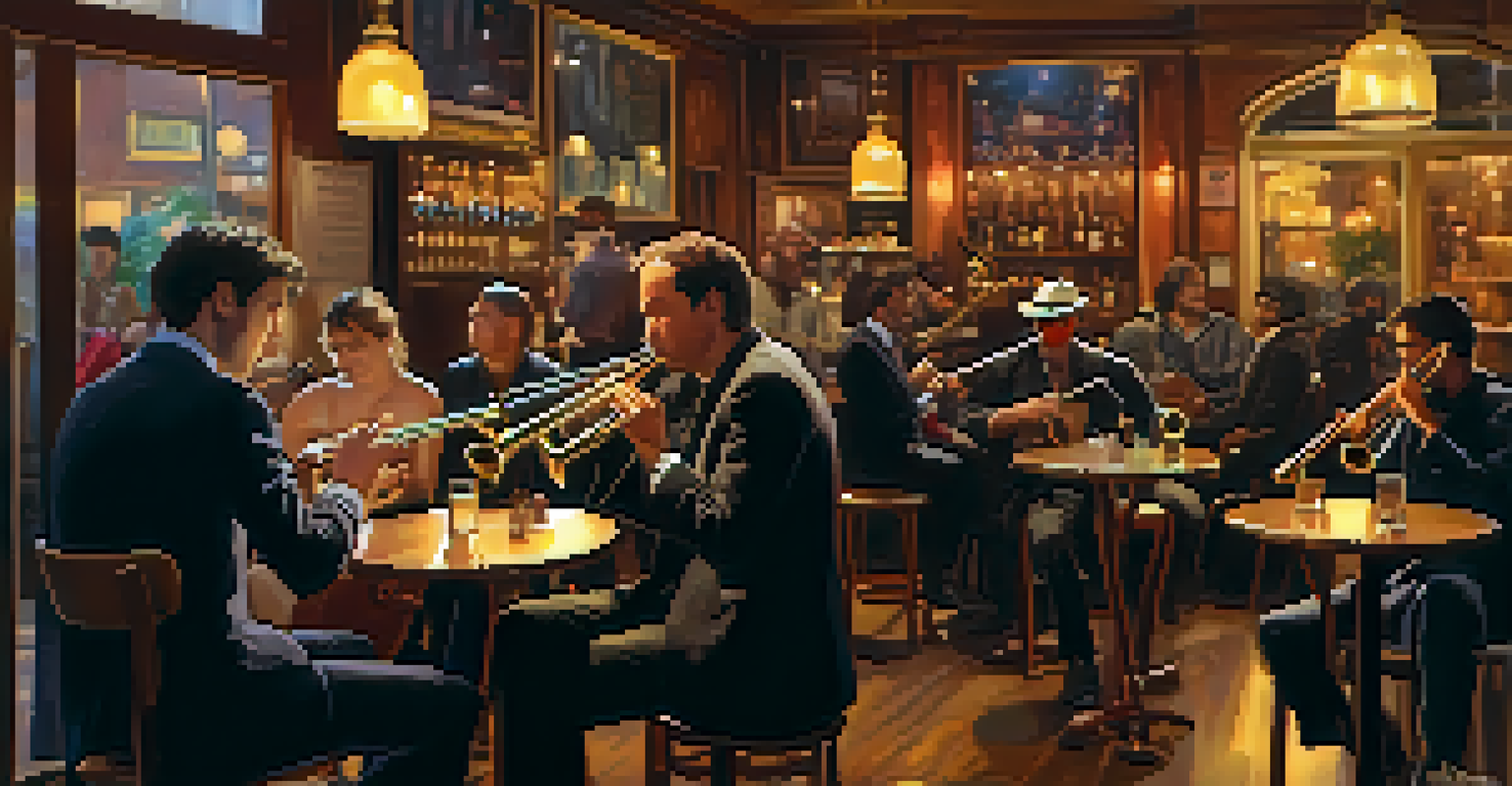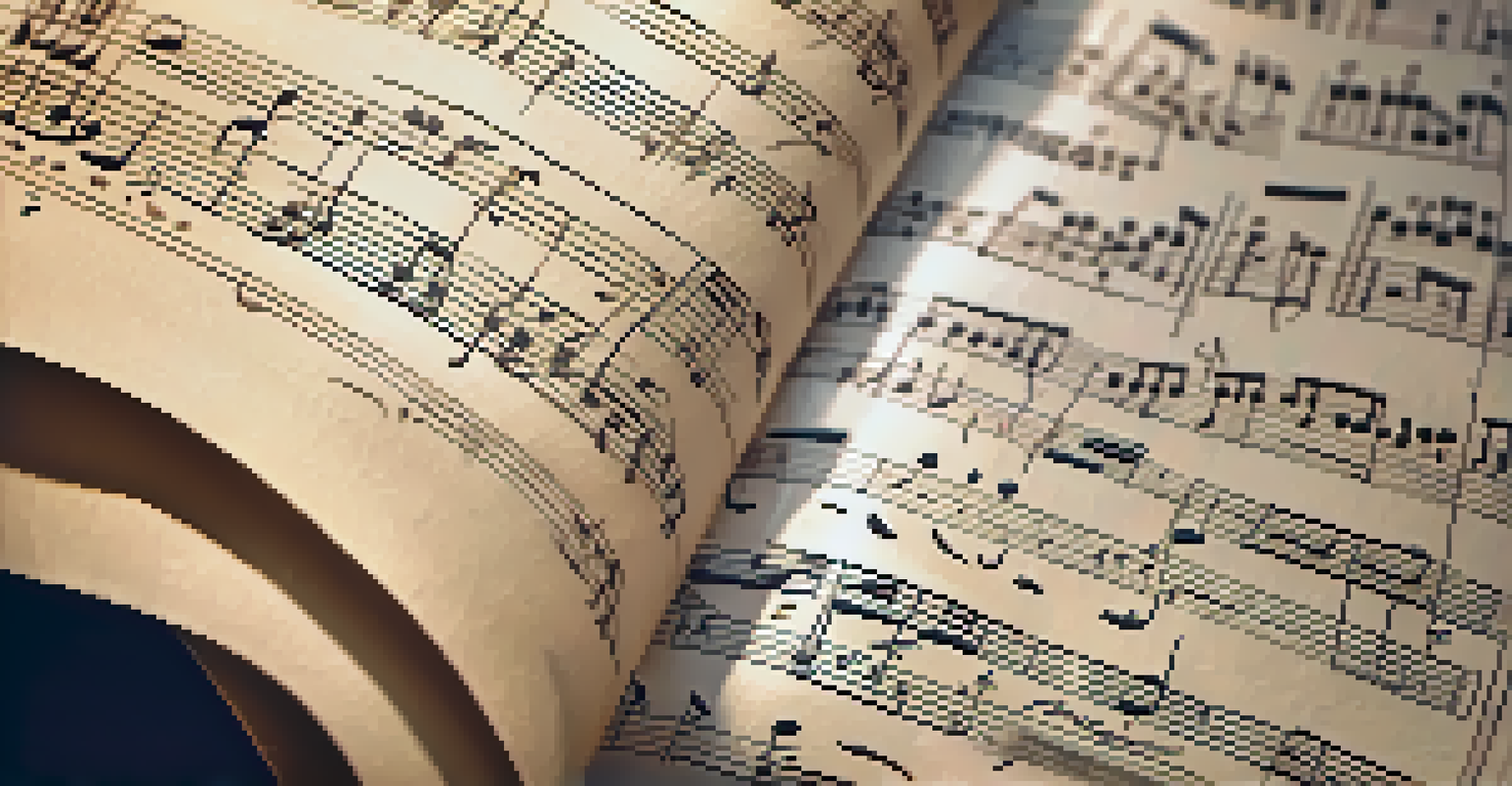Music Analysis and Emotion: Understanding Expressive Structures

The Connection Between Music and Emotion
Music has a profound ability to evoke emotions, often connecting deeply with listeners. This connection stems from various musical elements, like melody, harmony, and rhythm, which work together to create a specific mood. For instance, a fast tempo might energize you, while a slow, minor key can evoke feelings of sadness or nostalgia. Understanding this relationship is essential for analyzing how music expresses emotion.
Music can change the world because it can change people.
Moreover, different cultures and genres interpret emotions uniquely. For example, a classical symphony may convey a sense of grandeur, while a blues piece often expresses heartache. These variations highlight the rich tapestry of emotional expression in music, allowing listeners to experience a wide range of feelings through sound. By recognizing these differences, we can appreciate the complex emotional language that music speaks.
As we explore music analysis, we uncover not just the technical aspects but also the emotional narratives woven within compositions. This journey into emotion through music reveals how deeply ingrained our responses to sound are, shaping our experiences and memories. Ultimately, the connection between music and emotion is a powerful testament to the art form's impact on our lives.
Understanding Expressive Structures in Music
Expressive structures in music refer to the techniques and frameworks composers use to convey emotions. These structures can include dynamics, articulation, and phrasing, all of which contribute to the overall emotional landscape of a piece. For example, a sudden crescendo can create excitement or tension, while a gentle decrescendo might bring a sense of calm or resolution. Understanding these elements helps listeners appreciate the artistry behind emotional expression.

Analyzing how these expressive structures function in various genres reveals fascinating insights into emotional conveyance. In jazz, improvisation often leads to spontaneous emotional expressions, while classical music may rely on established forms like sonata or rondo to deliver a more structured emotional journey. Each genre has its own set of expressive tools, which can evoke different responses from the audience, adding to the richness of musical experience.
Music Evokes Deep Emotions
The interplay of melody, harmony, and rhythm in music creates a profound emotional connection for listeners.
Furthermore, recognizing the expressive structures in music allows us to engage more deeply with our listening experience. By identifying how composers manipulate these elements to elicit emotions, we become more attuned to the subtleties of the music. This heightened awareness not only enhances our enjoyment but also fosters a deeper appreciation for the skill and creativity involved in musical composition.
The Role of Melody in Emotional Expression
Melody is often considered the heart of music, playing a critical role in conveying emotions. A memorable melody can evoke joy, sadness, or nostalgia, often becoming the centerpiece of a piece. For instance, the iconic melody of 'Somewhere Over the Rainbow' evokes a sense of longing and hope, while the haunting melody of 'Adagio for Strings' resonates with profound sadness. This power of melody makes it a vital aspect of music analysis.
Without music, life would be a mistake.
When analyzing melodies, aspects like contour, interval, and range can reveal much about their emotional impact. A rising melody might create a feeling of uplift, while a descending line can suggest sadness or resignation. Additionally, the use of dissonance and consonance within a melody can add complexity to its emotional expression, allowing listeners to experience a range of feelings within a single musical phrase.
Ultimately, understanding the role of melody in emotional expression enriches our experience as listeners. By dissecting how different melodies evoke particular feelings, we can appreciate the nuances of music more fully. This exploration not only enhances our emotional connection to music but also encourages us to seek out melodies that resonate with our own experiences.
Harmony's Impact on Emotional Interpretation
Harmony, the combination of different musical notes played simultaneously, significantly influences emotional interpretation in music. Chords and progressions can create tension, resolution, or even a sense of longing, contributing to the overall emotional narrative of a piece. For example, a major chord often feels bright and uplifting, whereas a minor chord can evoke a sense of melancholy or introspection. This interplay of harmony and emotion is essential in music analysis.
Diving deeper into harmonic analysis reveals how specific chord progressions can elicit predictable emotional responses. The classic I-IV-V-I progression in pop music creates a sense of resolution and happiness, while a ii-V-I progression in jazz can convey a more complex emotional landscape. These patterns demonstrate how composers use harmony to guide listeners through emotional journeys, enhancing our understanding of the music.
Expressive Structures Enhance Emotion
Techniques like dynamics and phrasing enable composers to convey complex emotions, enriching the listening experience.
By examining harmony's role in emotional interpretation, we gain insight into the composer's intentions and the listener's experience. This understanding allows us to appreciate the intricate ways music communicates feelings through sound. As we explore different harmonies, we become more attuned to the emotional threads that run through the fabric of music.
Rhythm as an Emotional Catalyst
Rhythm is the heartbeat of music, dictating the flow and energy of a composition. It has a unique ability to evoke emotions through its pace and intensity. For example, a fast, driving rhythm can create excitement and urgency, while a slow, steady beat might evoke feelings of calm or contemplation. This rhythmic interplay adds another layer to the emotional landscape of music, making it a crucial aspect of analysis.
When analyzing rhythm, factors like meter, tempo, and syncopation come into play. A piece in 4/4 time often feels grounded and stable, while irregular meters can create a sense of unpredictability or tension. Syncopation, where the emphasis is placed on off-beats, can evoke surprise or excitement. Understanding these rhythmic elements helps us decipher the emotional cues embedded within a musical piece.
Ultimately, rhythm serves as an emotional catalyst, driving the listener's experience and response. By recognizing how rhythm influences emotions, we can engage more deeply with the music we love. This awareness not only enhances our enjoyment but also allows us to appreciate the artistry behind rhythmic composition.
Lyrics and Their Emotional Weight
Lyrics often serve as the narrative backbone of a song, providing context and depth to the emotional experience. They can convey stories, express feelings, or explore complex themes, making them a key element in music analysis. For instance, a heartfelt ballad may tell a story of lost love, allowing listeners to connect on a personal level. This lyrical connection enhances the emotional impact of the music.
When analyzing lyrics, factors such as imagery, metaphor, and word choice play a significant role. A powerful metaphor can evoke strong emotions, while vivid imagery can paint a picture that resonates with listeners. The way lyrics are delivered—through vocal inflection and phrasing—also contributes to their emotional weight. By considering these elements, we can gain a deeper understanding of the song's emotional landscape.
Listeners Shape Their Musical Journey
Each listener's unique experiences influence their emotional responses to music, highlighting its subjective nature.
Ultimately, lyrics add a rich layer to the emotional experience of music, allowing listeners to relate to the themes and feelings expressed. By engaging with the lyrics, we deepen our connection to the music, fostering a greater appreciation for the storytelling aspect of songwriting. This exploration not only enriches our listening experience but also highlights the power of words in music.
The Listener's Emotional Journey
The emotional journey of a listener is a vital aspect of music analysis, as it shapes how we experience and interpret a piece. Each individual brings their own experiences, memories, and emotions to the music, creating a unique connection. For instance, a song that reminds someone of a cherished memory may evoke feelings of joy, while the same song could trigger sadness for another listener. This personal connection underscores the subjective nature of musical experience.
Understanding the listener's emotional journey involves recognizing how music can facilitate emotional expression and processing. Music often serves as a tool for catharsis, helping individuals navigate their feelings during difficult times. By exploring our reactions to music, we can better understand ourselves and our emotional landscapes, fostering personal growth and healing.

Ultimately, the listener's emotional journey highlights the profound impact music has on our lives. By engaging with music on an emotional level, we not only enhance our enjoyment but also cultivate a deeper understanding of the human experience. This exploration of emotional responses to music emphasizes the art form's power to connect us all.